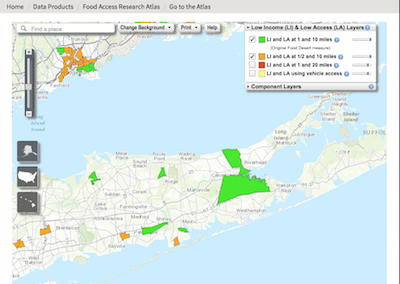December 2016
Nine of the locations are an easy commute to one of our three campuses, including a large green splotch that entirely encompasses the Eastern Campus in Riverhead. These are federally designated food deserts, areas identified by the U.S. Department of Agriculture as low-income census tracts where a significant number or share of residents are deemed too far from the nearest supermarket:
Proximity to supermarkets is used as a measurement because they consistently offer an array of affordable, healthy food—fresh fruit and vegetables, in particular—unlike the convenience stores and fast food places that tend to populate lower income communities. And "walkability" is generally considered to be a half-mile radius around a community service, so the one-mile measurement used to determine food deserts is deemed more severe.
Long Island's reputation as having an inordinately high cost of living and being populated by affluent communities leads many to believe that food insecurity isn't a significant issue here. But it certainly is. A lengthy 2013 report by Adelphi University's Center for Health Innovation estimates that "more than 300,000 of our fellow residents live in food poverty, uncertain whether they will be able to eat an adequate amount of nutritious food each day." The Long Island Cares food bank notes that about 283,700 people on Long Island receive emergency food each year, or 64,900 people every week and, of these, 39 per cent are age 18 or under. Knowing that our own students are among those facing such food instability, the FA has increased the amount of food it donates each fall to the three campus food pantries. This fall, the FA donated $400 to the Eastern Campus food pantry, $400 to the Ammerman FEAST food pantry and $400 to the Grant Campus food bank. Please spread the word with students that should they or another student need a bit of assistance when facing food instability, they can visit the Campus Activities office on their campus for help. Donations on all three campuses are distributed with the greatest of discretion. |

